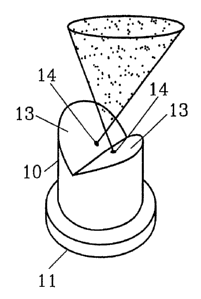Une partie des informations de ce site Web a été fournie par des sources externes. Le gouvernement du Canada n'assume aucune responsabilité concernant la précision, l'actualité ou la fiabilité des informations fournies par les sources externes. Les utilisateurs qui désirent employer cette information devraient consulter directement la source des informations. Le contenu fourni par les sources externes n'est pas assujetti aux exigences sur les langues officielles, la protection des renseignements personnels et l'accessibilité.
L'apparition de différences dans le texte et l'image des Revendications et de l'Abrégé dépend du moment auquel le document est publié. Les textes des Revendications et de l'Abrégé sont affichés :
| (12) Brevet: | (11) CA 2232619 |
|---|---|
| (54) Titre français: | BUSE ET PROCEDE D'ALIMENTATION EN PLASTIQUE THERMODURCISSABLE |
| (54) Titre anglais: | A NOZZLE AND A METHOD FOR FEEDING THERMOSETTING PLASTIC |
| Statut: | Périmé |
| (51) Classification internationale des brevets (CIB): |
|
|---|---|
| (72) Inventeurs : |
|
| (73) Titulaires : |
|
| (71) Demandeurs : |
|
| (74) Agent: | MARKS & CLERK |
| (74) Co-agent: | |
| (45) Délivré: | 2009-05-12 |
| (86) Date de dépôt PCT: | 1996-09-24 |
| (87) Mise à la disponibilité du public: | 1997-04-03 |
| Requête d'examen: | 2002-10-21 |
| Licence disponible: | S.O. |
| (25) Langue des documents déposés: | Anglais |
| Traité de coopération en matière de brevets (PCT): | Oui |
|---|---|
| (86) Numéro de la demande PCT: | PCT/SE1996/001197 |
| (87) Numéro de publication internationale PCT: | WO1997/011784 |
| (85) Entrée nationale: | 1998-03-20 |
| (30) Données de priorité de la demande: | ||||||
|---|---|---|---|---|---|---|
|
L'invention concerne une buse d'alimentation pour un mélange de plastique thermodurcissable et de durcisseur contenu dans une chambre de mélange à laquelle sont connectées des conduits d'alimentation du plastique thermodurcissable et du durcisseur. La chambre de mélange communique avec au moins deux canaux à jet (14) d'un diamètre (b) compris entre 0,5 et 1,5 mm, qui convergent vers un point extérieur à la buse en formant un angle ( alpha ) compris entre 70 et 140 DEG . L'alimentation du mélange de plastique thermodurcissable et de durcisseur par la buse, est caractérisée en ce que le mélange présente une viscosité comprise entre 150 et 75,000 cpois et est extrudé par la buse avec une pression de 75 à 100 bar.
A nozzle for feeding a mixture of thermosetting
plastic and hardener from a mixing chamber, to which
feed lines for supply of thermosettable plastic as well
as the hardener are connected. The mixing chamber
communicates with at least two beam channels (14) having
a diameter (b) of 0.5-1.5 mm, which converge in an angle
(a) of 70-140° towards a point outside the nozzle. By
feeding a mixture of thermosetting plastic and hardener via
the nozzle, the mixture has a viscosity of between 150 and
75.000 cpois, and that the mixture is extruded from the
nozzle with a pressure of 75 to 100 bar.
Note : Les revendications sont présentées dans la langue officielle dans laquelle elles ont été soumises.
Note : Les descriptions sont présentées dans la langue officielle dans laquelle elles ont été soumises.

Pour une meilleure compréhension de l'état de la demande ou brevet qui figure sur cette page, la rubrique Mise en garde , et les descriptions de Brevet , États administratifs , Taxes périodiques et Historique des paiements devraient être consultées.
| Titre | Date |
|---|---|
| Date de délivrance prévu | 2009-05-12 |
| (86) Date de dépôt PCT | 1996-09-24 |
| (87) Date de publication PCT | 1997-04-03 |
| (85) Entrée nationale | 1998-03-20 |
| Requête d'examen | 2002-10-21 |
| (45) Délivré | 2009-05-12 |
| Expiré | 2016-09-26 |
Il n'y a pas d'historique d'abandonnement
Les titulaires actuels et antérieures au dossier sont affichés en ordre alphabétique.
| Titulaires actuels au dossier |
|---|
| APLICATOR SYSTEM AB |
| Titulaires antérieures au dossier |
|---|
| SAND, KJELL |